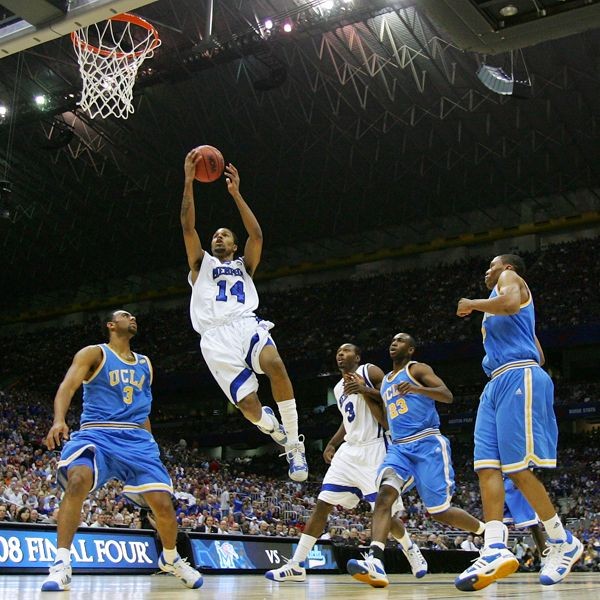It’s going to be interesting to see, as the years unfold, how the Calipari Era at the University of Memphis — and an era, it certainly was — is treated by historians. With the period’s peak season (2007-08) now “vacated” in the record books, there is sure to be collateral damage to the players from this era and, more specifically, that season. But with an optimist’s heart overriding a skeptic’s brain, I’d argue Chris Douglas-Roberts will become history’s unblemished face of the extraordinary on-court success of Calipari’s nine years at the U of M. A first-team All-American and a starter for three teams that reached at least the Elite Eight of the NCAA tournament (with only one vacated), CDR is the third most significant Memphis athlete of the decade.
 Ronald Martinez/Getty Images
Ronald Martinez/Getty Images
He arrived from Detroit with an oddly hyphenated name, a member of the 2005 recruiting class that included Antonio Anderson, Robert Dozier, and Shawne Williams. He took the floor wearing a t-shirt a size too big under his jersey, and was hardly a smooth end-to-end offensive dynamo like Derrick Rose or Tyreke Evans. But Douglas-Roberts was a scorer, in the mold of Hall of Famer Adrian Dantley. He could shoot (37 percent from three-point range for his career), but he was best with the ball in traffic, inside ten feet. Off balance, on the wrong foot, odd angles . . . it never mattered with CDR. He was in scoring position when the ball reached his hands.
CDR started 25 games as a freshman on a team loaded with the likes of Rodney Carney, Darius Washington, Joey Dorsey and his own talented classmates. He led the Tigers in scoring (23 points) in just his fifth game, a blowout win over Lamar at FedExForum. He was a key contributor for a team that went 33-4 and won its first Conference USA tournament title.
The 2006-07 season saw CDR emerge as the team’s top scoring option. He averaged 15.4 points per game and seemed to embrace the spotlight, canning a game-winning bucket at Gonzaga in February and earning C-USA tournament MVP honors as the Tigers defended their title in March. He fouled out of the season-ending loss to Ohio State in the NCAA tournament, the first such disqualification of his career.
CDR opened the 2007-08 season (add an asterisk here, if you must) by appearing on the cover of Sports Illustrated and ended it playing a central role in the heartbreak of a championship that seemed stolen at the time. In between, he merely led the Tigers in scoring 19 times, was the hero in a late rally at UAB that extended the Tigers’ season-opening winning streak to 25 games, catapulted his team to the top ranking in the country, and pushed the U of M to its first Final Four appearance in 23 years. He became the third Tiger to earn C-USA Player of the Year honors and finished his career ranked ninth in scoring. (Among those ahead of CDR, only Keith Lee and Larry Finch scored more points in their first three years.)
Then came April 7, 2008, in San Antonio. The Tigers held a nine-point lead with less than three minutes to play in the national championship game against Kansas, only to see the Jayhawks drop in one field goal after another, as the Tigers missed free throws that would have clinched the title. Having shot 72 percent from the stripe over his college career, Douglas-Roberts missed three of four attempts during this late-game collapse, allowing the game-tying heroics of Mario Chalmers at the buzzer. (He had made nine of 11 against UCLA in the national semis and drained his first five against Kansas.) We tend to like our athletic heroes to prove they’re human at times. CDR just did so on the brightest stage of his young career.
Douglas-Roberts was chosen by the New Jersey Nets in the first round of the 2008 NBA draft and averaged 4.9 points over 44 games in a rookie season hampered by injury. When he made a midseason appearance at FedExForum for a Tiger game, though, and was introduced to the throng of Memphis fans who will never forget him, the chants of “CDR!” were loud enough to emanate well beyond the current decade.